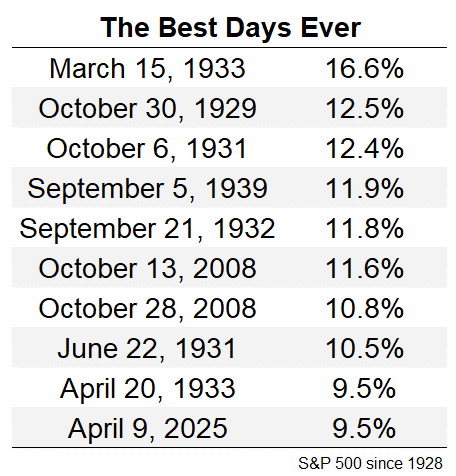What a wild past week and a half in the stock market.
On Thursday, April 3rd, the U.S. stock market dropped 4.8%. Then the following Friday, it declined by another 6%. The combined 2-day loss of 10.5% was the fifth-worst two-day stretch for the stock market since 1950.
Safe to say, there was plenty of panic to go around over the ensuing weekend.
Last Monday was somewhat uneventful, and then the market dropped almost 4% again on Tuesday.
When the mood surrounding the stock market was maybe at its lowest point, seemingly out of nowhere, President Trump announced he was delaying many of his planned tariffs, and the market ripped upward.
Last Wednesday, the S&P 500 rose a whopping 9.5%.
We went from some of the worst market days to one of the best days ever in less than a week. Last Wednesday was the tenth-best day ever, dating back to 1928:

There have only been two days (both in 2008) in the past 86 years when the market went up as much as it did last Wednesday.
Then on Thursday the market dipped 2% and on Friday it recovered that same 2%.
The events of the past week and a half in the stock market, and especially last Wednesday, reminded me of how important it is to stay invested during these volatile times.
I know many people who were trying to time the market by either cashing out some of their investments or waiting to invest until they saw how the tariff situation played out. I would guess at least some of those people are a little bummed they missed out on a massive 9.5% gain last week.
I would also guess that they’re still waiting around and telling themselves that they’ll be sure to get in for the next market surge. That may be true, but you can’t keep missing out on too many of these “good days” before you start to see a negative impact on your long-term returns.
The following graph from J.P. Morgan shows how missing only a few days of strong returns can drastically impact your overall investment performance:

Over 20 years, there are about 5,060 trading days. If you missed out on 10 of the best-performing days, you would go from a 7x return on your initial investments to a 3x return. That’s all it takes; you would cut your return in half by missing a mere ten days over 20 years.
If you missed only 40 of the best performing days you would have received a negative total return over the past 20 years. You can go from septupling your money to having less than you started with by just missing 40 days out of 5,060.
The task of picking those good days goes from hard to impossible when you understand that the best days and the worst days often happen close together.
Over the past two decades, seven of the ten best days occurred within two weeks of the ten worst days.
We witnessed this exact thing last week.
Volatility tends to cluster — the best days in the market are often concentrated around the worst days in the market.
The majority of your investment returns are built on just a few good days or weeks of market performance. The only way to guarantee that you’ll be able to take advantage of the best days is to stay invested and stick around during the worst days.
Peter Lynch (legendary investor) once said:
“Far more money has been lost by investors preparing for corrections or trying to anticipate corrections than has been lost in corrections themselves.”
Thanks for reading!

Jake Elm, CFP® is a financial advisor at Dentist Advisors. Jake a graduate of Utah Valley University’s nationally ranked Personal Financial Planning program. As a financial advisor at Dentist Advisors, he provides dentists with fiduciary guidance related to investments, debt, savings, taxes, and insurance. Learn more about Jake.</em

